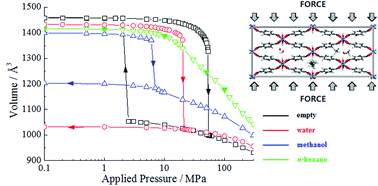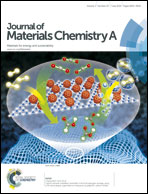Guest-modulation of the mechanical properties of flexible porous metal–organic frameworks†
Abstract
The highly flexible hybrid nanoporous MOF MIL-53(Cr) was evoked as a potential medium to store mechanical energy via a structural switching from an open to a close pore form under moderate applied external pressures. Herein, we show that the inclusion of a low concentration of either polar or apolar molecules into the pores can finely tune the structural and energetic behaviour of this solid under compression–decompression. This allows a modulation of the material's storage abilities in the form of not only nano-springs/dampers but also shock adsorbers by confining n-alkane and water–alcohol, respectively. Predicting and further understanding the impact of each guest on the mechanical properties of this MOF are achieved by molecular dynamics simulations based on a refined version of a flexible force field able to accurately capture the breathing of the framework. A careful analysis of the host–guest interactions and the preferential conformations of the confined molecules validated by in situ X-ray diffraction and microcalorimetry data shed light on the microscopic mechanisms at the origin of the singular mechanical behaviour of each guest loaded material.


 Please wait while we load your content...
Please wait while we load your content...